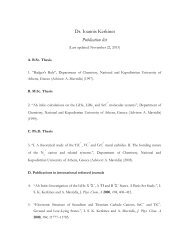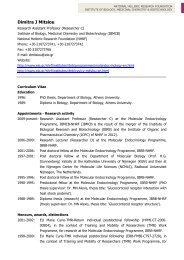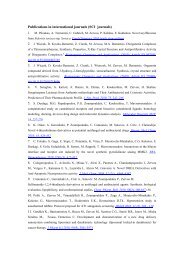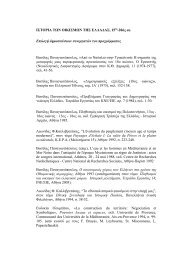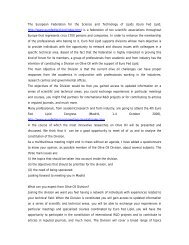Detailed CV
Detailed CV
Detailed CV
You also want an ePaper? Increase the reach of your titles
YUMPU automatically turns print PDFs into web optimized ePapers that Google loves.
NATIONAL HELLENIC RESEARCH FOUNDATIONINSTITUTE OF BIOLOGY, MEDICINAL CHEMISTRY & BIOTECHNOLOGYZoumpourlis VassilisDirector of Research, Head of the research team of Biomedical Applications Unit,Institute of Biology, Medical Chemistry and BiotechnologyPhone: +30-210-7273730 (Office), 7273731 (Lab)Fax: +30 210 7273677E-mail: vzub@eie.grWebsite: http://www.eie.gr/nhrf/institutes/ibrb/serviceunits/bau-en.htmlEDUCATION/TRAININGINSTITUTION AND LOCATIONDEGREE(if YEAR(s) FIELD OF STUDYapplicable)Univ. J E Purkyne, Brno, Czech Rep. (1981-1986) Diploma 5 Mol. Biology andUniv. J E Purkyne, Brno, Czech Rep. (1986-1987) M.Sc. 1 Genetics Mol. GeneticsNat Hellenic Research Foundation (1989-1994) PhD 4 Mol. Biology of HIV-1Nat Hellenic Research Foundation (1994-1998) Post-Doc/ 5Mol. Biology of cancerPositions and Employment1989-1994 PhD, IBRB, NHRF Post-Doc1994-1998 Post-Doc1998-2003 Functional Scientist, Grade B, IBMCB, NHRF2003-2006 Functional Scientist, Grade A, IBMCB, NHRF2006-2013 Research Associate Professor, IBMCB, NHRF20013- Research Professor IBMCB, NHRFCancer2002- Head of the research team of Biomedical Applications Unit, IBMCB,NHRF.RESEARCH ACTIVITIES ABROAD1992 Visitor researcher, Molecular Oncology Group, Department of Clinical DentalSciences, The University of Liverpool, UK1993 Visitor researcher, Molecular Oncology Group, Department of Clinical DentalSciences, The University of Liverpool, UK1995 Visitor researcher, Marie Curie Institute, Paris, France1998 Visitor researcher, Department of Molecular Cell Biology, Sylvius Laboratory, Leiden,Netherlands2002 Visitor researcher, Department of Molecular Biology, Amsterdam, Netherlands2004 Visitor researcher, Department of Molecular Oncology, Mazaryk Institute, Brno,Czech R2005 Visitor researcher, Department of Molecular Oncology, Mazaryk Institute, Brno,
NATIONAL HELLENIC RESEARCH FOUNDATIONINSTITUTE OF BIOLOGY, MEDICINAL CHEMISTRY & BIOTECHNOLOGYAP-1 transcription factors (Zoumpourlis et al Oncogene 19: 4011-4021, 2000;Katsanakis et al Molecular Med 8: 624-637, 2002; Zoumpourlis et al Carcinogenesis 24:1159-1165, 2003; Papassava et al Cancer Res 64: 8573-8584, 2004; Vlahopoulos etal,. Bioessay 30: 314-327, 2008), steroid receptors (Bakas P et al Fert. Ster. 1: 1-8,2008; Logotheti et al PLoS One.;7(8):e41957. Epub 2012 Aug 3, 2012), members ofthe p53 tumor suppressor gene family (p73 isoforms) (Logotheti et al FEBS J 277:3014-3027, 2010; Daskalos et al Cancer Lett. 300: 79-86, 2011) and Ras homologyoncogenes (Rho family members) (Psichari et al J Biol Chem. 277: 29490-29495, 2002;Volanis et al. Toxicol Lett. 193: 131-137, 2010; Volanis et al J. BUON 16(3):511-21,2011). To this end, the well-established mouse skin carcinogenesis system, as well ashuman cell lines and tumors from various types of cancer, such as bladder, lung anduterine cancers have been recruited over the years. The ultimate goal is theidentification of candidate genes that could be eligible for molecular targeting in termsof cancer therapeutics. At the same time, the group has participated in collaborativeprojects for the elucidation of the role of appealing putative targets, such as KLK6,KLK5 (Pampalakis et al, Cancer Research 69: 3779-87, 2009), Src oncoprotein(Woodcock et al Molecular Cell 33, 1-15, 2009), the replication licensing factors hCdt1and hCdc6 (Liontos et al Cancer Research 67: 10899 -10909, 2007; Bartkova et alNature 444: 633-637, 2006) and Ptch1gene (Hio Chung Kang et al. International J ofDermatology, Dec 6. doi: 10.1038/jid.2012.419, 2012) in cancer.Dr Vasilis Zoumpourlis’ group has recently extended its activities towards the intriguingresearch of stem cells and their applications in cancer therapeutics, through a fruitfulcollaboration with the TAK-EIE stem cell bank, an NHRF spin-off company(Christodoulou et al. Proliferation kinetics and phenotypic properties of hMSCs derivedfrom fetal umbilical cord (Wharton’s jelly) and adult adipose tissue during prolonged invitro culture. International J of Stem Cells, 2013; Christodoulou I and V Zoumpourlis.Exploing the use of mesenchymal stem cell population in cancer cytotherapy. CancerBiology and Therapy, Submitted, 2013). More specifically, the current aim of the groupis to develop a safe MSC-based anticancer therapeutic strategy employing the SB100Xtransposon biotechnology, using in vitro and in vivo models (Petrakis et. al. Gatewaycompatibletransposon vector to genetically modify human embryonic kidney andadipose-derived stromal cells. Biotechnol J. 2012 Feb 10. doi: 10.1002/biot.201100471.[Epub 2012 Mar 7]). The challenge that the group has been confronting for the lastthree years is the use of MSC-based approaches for targeting specifically cancer cells.The current challenge of Dr Vasilis Zoumpourlis’ group is to develop new generationtranslational products for cytotherapy-based cancer management and testing of drugs.To this end, it has recently transferred its long-term experience and know-how inmolecular biology of cancer in the emerging field of stem-cell biology, in order (a) todesign stem cell-based vehicles for effective and specific tumour targeting and (b) to
NATIONAL HELLENIC RESEARCH FOUNDATIONINSTITUTE OF BIOLOGY, MEDICINAL CHEMISTRY & BIOTECHNOLOGYdevelop improved in vitro preclinical assays for quick and reliable assessing oftoxicology and safety profiles of drugs.List of publicationsPeer-reviewed Publications1. Christodoulou I, Kritikos A, Koliakos G and Zoumpourlis V. Exploring the use ofmesenchymal stem cell population in cancer cytotherapy. Stem Cells Int.Submitted 20132. Christodoulou I, Kritikos A, Koliakos G and Zoumpourlis V. Human MSC DerivedFrom Fetal Umbilical Cord (Wharton’s Jelly) Serve As An Accurate Model ForAcute Drug Toxicity Screening. Plos One Submitted 20133. Georgios Pampalakis, Osahon Obasuyi, Olga Papadodima, AristotelisChatziioannou, Vassileios Zoumpourlis, Georgia Sotiropoulou. Kallikrein-relatedpeptidase 5 is a novel suppressor of breast cancer that may exert its effects byrepressing the mevalonate pathway. Oncotarget 2013 Sep 3. [Epub aheadof print].4. Georgia Velimezi, Michalis Liontos, Konstantinos Vougas, TheodorosRoumeliotis, Maria Sideridou, Ayguel Dereli-Oz, Maciej Kocylowski, Ioannis SPateras, Kostas Evangelou, Athanassios Kotsinas, Ines Orsolic, Sladana Bursac,Maja Cokaric-Brdovak, Vassilis Zoumpourlis, Dimitris Kletsas, George Papafotiou,Apostolos Klinakis, Sinisa Volarevic, Wei Gu, Jiri Bartek8, Thanos D. Halazonetis,Vassilis Gorgoulis. Functional interplay between the DNA damage responsekinase ATM and ARF tumour suppressor protein in human cancer. Nat CellBiol. 2013 Aug;15(8):967-77. doi: 10.1038/ncb2795. Epub 2013 Jul14.5. Logotheti S, Pavlopoulou A, Galtsidis S Vojtesek Β. and Zoumpourlis V.Functional discrimination of TAp73 isoforms in oncogenesis based on differencesin their C-terminal domain. Cancer Metastasis Rev. 2013 Apr 17. [Epubahead of print].6. Christodoulou I, Kolisis FN, Papaevangeliou D and V Zoumpourlis. Proliferationkinetics and phenotypic properties of hMSCs derived from fetal umbilical cord(Wharton’s jelly) and adult adipose tissue during prolonged in vitro culture.Stem Cells International, Volume 2013, Article ID 246134, 12 pages.2013
NATIONAL HELLENIC RESEARCH FOUNDATIONINSTITUTE OF BIOLOGY, MEDICINAL CHEMISTRY & BIOTECHNOLOGY7. Georgakopoulou E.A., Tsimaratou K1, Evangelou K1., Pablo Jose FernadezMarcos, Zoumpourlis V, Trougakos IP., Kletsas D, Bartek J., Serrano M.,Gorgoulis VG. Specific lipofuscin staining by Sudan Black B as a novel approachto detect senescent cells in vitro, as well as in cryo-preserved and archivaltissues. AgingJ Aging (Albany NY) Jan 5;5(1):37-50, 20138. Hio Chung Kang, Yuichi Wakabayashi, Kuang-Yu Jen, Jian-Hua Mao, VassilisZoumpourlis, Reyno De Rosario, and Allan Balmain. Ptch1 overexpression drivesskin carcinogenesis and developmental defects in K14PtchFVB mice.International J of Dermatology, Dec 6. doi: 10.1038/jid.2012.419,20129. Rizos E, Siafakas N, Koumarianou A, Katsantoni E, Filippopoulou A, Ntounas P,Touloumis Ch, Kastania A, Zoumpourlis V. miR-183 as a molecular andprotective biomarker for cancer in schizophrenic subjects. Oncol Rep. 2012Dec;28(6):2200-4. doi: 10.3892/or.2012.2052. Epub 2012 Sep 21.10. Stella logotheti, Dimitra Papaevangeliou, Ioannis Christodoulou, KaterinaPyrillou, John Michalopoulos, Vassilis G. Gorgoulis, Spiros Vlachopoulos andVassilis Zoumpourlis. Involvement of Estrogen Receptor alpha (ERα) in MouseSkin Carcinogenesis PLoS One.;7(8):e41957. Epub 2012 Aug 3, 201211. Ioannis Aivaliotis, Antonia Daleziou, Ioannis Pateras, Vassilis Zoumpourlis. “Howdo cytokines trigger genomic instability?” J Biomed Biotechnol. :536761.Epub 2012 Jun 17, 201212. Volanis D, Zaravinos A, Kadiyska T, Delakas D, Zoumpourlis V, SpandidosDA.Expression profile of Rho kinases in urinary bladder cancer. J. BUON16(3):511-21, 201113. Alexandros Daskalos, Soultana Markopoulou, George Xenarianos, John RCosney, Stella Logotheti, Vassilis Zoumpourlis. John K. Field, and TriantafyllosLiloglou. Global DNA hypomethylation-induced DNP73 transcriptional activationin non-small cell lung cancer. Cancer Letters 300:79-86, 201114. Logotheti S, Michalopoulos I, Sideridou M, Daskalos A, Kossida S, Spandidos DA,Field JK, Vojtesek B, Liloglou T, Gorgoulis V, Zoumpourlis V. Sp1 binds to theexternal promoter of the p73 gene and induces the expression of TAp73gammain lung cancer. FEBS J 277: 3014-3027, 2010
NATIONAL HELLENIC RESEARCH FOUNDATIONINSTITUTE OF BIOLOGY, MEDICINAL CHEMISTRY & BIOTECHNOLOGY23. Bakas P, Liapis A, Vlahopoulos S, Giner M, Logotheti S, Creatsas G, Meligova AK,Alexis MN, Zoumpourlis V. Estrogen receptor alpha and beta in uterine fibroids:a basis for altered estrogen responsiveness. Fert. Ster. 1: 1-8, 200824. Liontos M, Koutsami M, Sideridou M, Evangelou K, Kletsas D, Levy B, KotsinasA, Nahum O, Zoumpourlis V, Kouloukoussa M, Lygerou Z, Taraviras S, Kittas C,Bartkova J, Papavassiliou AG, Bartek J, Halazonetis TD, Gorgoulis VG.Deregulated overexpression of hCdt1 and hCdc6 promotes malignant behavior.Cancer Research 67: 10899 -10909, 200725. Bartkova J, Rezaei N, Liontos M, Karakaidos P, Kletsas D, Issaeva N, VassiliouLV, Kolettas E, Niforou K, Zoumpourlis VC, Takaoka M, Nakagawa H, Tort F,Fugger K, Johansson F, Sehested M, Andersen CL, Dyrskjot L, Orntoft T, LukasJ, Kittas C, Helleday T, Halazonetis TD, Bartek J, Gorgoulis VG. Oncogeneinducedsenescense is part of the tumorigenesis barrier imposed by DNAdamage checkpoints. Nature 444: 633-637, 200626. Vlahopoulos S, Zimmer WE, Jenster G, Belaguli NS, Balk SP, Brinkmann AO,Lanz RB, Zoumpourlis V and Schwartz RJ. Recruitment of the androgen receptorvia serum response factor facilitates expression of a myogenic gene. JBC 280:7786-9, 200527. Papoutsi Z, Kassi E, Papaevangeliou D, Pratsinis H, Zoumpourlis V, Halabalaki M,Mitakou S, Kalofoutis A and P moutsatsou. Plant 2-Arylobenzofuransdemonstrate a selective estrogen receptor modulator profile. Steroids 69:727-734, 200428. Papassava P, Gorgoulis V, Papaevangeliou D, Vlahopoulos S, van Dam H, andZoumpourlis V. Overexpression of Activated Transcription Factor 2 is requiredfor tumor growth and progression in mouse skin tumors. Cancer Res 64:8573-8584, 2004.29. Vlachopoulos S and V Zoumpourlis. “JNK”: a key modulator of intracellularsignaling. Biochemistry (Moscow) 69: 844-854, 200430. Zoumpourlis V, Solakidi S., Papathoma A. and Papaevangeliou D. Geneticalterations in signal transduction pathways implicated in tumour progression
NATIONAL HELLENIC RESEARCH FOUNDATIONINSTITUTE OF BIOLOGY, MEDICINAL CHEMISTRY & BIOTECHNOLOGYduring multistage mouse skin carcinogenesis. Carcinogenesis 24: 1159-1165, 2003.31. Gorgoulis V, Zacharatos P, Mariatos G, Kletsas D, Zoumpourlis V, Kittas Ch,Ryan K and Papavassiliou A.. p53 activates ICAM-1 (CD54) expression in an NFκB-independentmanner. EMBO J 22: 1567-1578, 200332. Gazouli M, Kokotas S, Zoumpourlis V, Zacharatos P, Mariatos G, Kletsas D,Kittas Ch and Gorgoulis V. The complement inhibitor CD59 and the lymphocytefunction-associated antigen-3 (LFA-3, CD58) genes possess functional bindingsites for the p53 tumor suppressor protein. Anticancer Research 22: 4237-4242, 2002.33. Katsanakis KD, Gorgoulis V, Papavassiliou A and Zoumpourlis V. Theprogression in the mouse skin carcinogenesis model is dependent on ERK1/2signaling. Molecular Med 8: 624-637, 200234. Psichari E, Balmain A, Plows D, Zoumpourlis V and Pintzas A. High activity ofserum response factor in the mesenchymal transition of epithelial tumor cells isregulated by Rho signaling. J Biol Chem. 277, 29490-29495, 2002.35. Katsanakis K, Owen C, Zoumpourlis V. JNK and ERK signaling pathways inmultistage mouse carcinogenesis: studies in the inhibition of signaling cascadesas a means to understand their in vivo biological role. Anticancer Research22, 755-760, 2002.36. Plows D, Briassouli P, Owen C, Zoumpourlis V, Garrett M and A Pintzas.Ecdysone-inducible expression of oncogenic Ha-Ras in NIH 3T3 cells leads totransient nuclear localization of activated extracellular signal-regulated kinaseregulated by mitogen-activated protein kinase phospatase-1. Biochem J 362,305-315, 200237. Papathoma A, Zoumpourlis V, Balmain A and A Pintzas. Role of MatrixMetalloproteinase-9 in Progression of Mouse Skin Carcinogenesis. MolecularCarcinogenesis 31, 74-82, 2001.38. Kotsinas A, Gorgoulis VG, Zacharatos P Mariatos G, Kokotas S, Liloglou T,Ikonomopoulos Zoumpourlis V, Kyroudi A, Field JK, Asimakopoulos PJ and KittasCh. Additional characterizaation of a hexanucleotide polymorphic site in the first
NATIONAL HELLENIC RESEARCH FOUNDATIONINSTITUTE OF BIOLOGY, MEDICINAL CHEMISTRY & BIOTECHNOLOGYintron of human H-ras gene: comparative study of its alterations in non-smallcell lung carcinomas and sporadic invasive breast carcinomas. CancerGenetics and Cytogenetics 126, 147-154, 200139. Gorgoulis VG, Zacharatos P Mariatos G, Liloglou T, Kokotas S, Kastrinakis N,Kotsinas A, Athanasiou A, Foukas P, Vogiatzi T, Zoumpourlis V, Kletsas D,Ikonomopoulos J, Asimakopoulos PJ, Rossidakis G, Kittas Ch and Field JK.Deregulated expression of c-mos in non-small cell lung carcinomas:Relationship with p53 status, genomic instability and tumor kinetics. CancerResearch 61, 538-549, 200140. Zoumpourlis Vassilis, Papassava Paraskevi, Linardopoulos Spyros, GillespieDavid, Balmain Allan and Alexandros Pintzas. High levels of phosphorylated c-jun, Fra-1, Fra-2 and ATF-2 proteins correlate with malignant phenotypes in themultistage mouse skin carcinogenesis model. Oncogene 19, 4011-4021,2000.41. Gorgoulis VG, Zacharatos PV, Kotsinas A, Mariatos G, Liloglou T, Vogiatzi T,Foukas P, Rassidakis G, Garinis G, Ioannides T, Zoumpourlis V, Michail P O,Manolis EN, Field JK and Kittas Ch. Altered expression of the cell cycleregulatory molecules pRb, p53 and MDM2 exert a synergetic effect on tumorgrowth and genomic instability in Non-Small Cell Lung Carcinomes (NSCLCs).Molecular Medicine 6, 208-237, 200042. Gorgoulis V, Zacharatos P, Manolis E, Ikonomopoulos A, Damalas A, RassidakisG, Zoumpourlis V, Kotsinas A, Rassidakis AN, Halazonetis T and Kittas C.Effects of p53 mutants derived from lung carcinomas bind the p53 - responsiveelement (p53 RE) of the MDM-2 gene. Relationship with MDM-2 expression.British Journal of Cancer 77, 374-384, 199843. Christeli E, Zoumpourlis V, Kiaris H, Ergazaki M, Vassilaros S and Spandidos DA.TGF-β1overexpression in breast cancer. Correlation with clinicopathologicaldata. Oncology Reports 3, 115-118, 199644. Gorgoulis V, Zoumpourlis V, Rassidakis GZ, Rassidakis AN, Spandidos DA andKittas Ch. A molecular and immunohistochemical study of the MDM2 proteinisoforms and p53 gene product in bronchogenic carcinoma. JournalPathology 180, 129-137, 1996.
NATIONAL HELLENIC RESEARCH FOUNDATIONINSTITUTE OF BIOLOGY, MEDICINAL CHEMISTRY & BIOTECHNOLOGY45. Zoumpourlis V and Spandidos DA. Transcriptional activation of the humanimmunodeficiency virus long terminal repeat sequences by retinoic acid inhuman epithelial and fibroblast tumor cell lines. Journal of BiologicalMarkers 11, 153-158, 1996.46. Zoumpourlis V, Zachos G, Halazonetis TD and Spandidos DA. Binding of wildtypeand mutant forms of p53 protein in a specific DNA sequence of the firstintron of the H-ras oncogene. International Journal of Oncology 7, 1035-1041, 1995.47. Spandidos DA, Zoumpourlis V, Zachos G, Toas SH and Halazonetis TD. Specificrecognition of a transcriptional element within the human H-ras proto-oncogeneby the p53 tumor suppressor. International Journal of Oncology 7, 1029-1034, 1995.48. Zachos G, Zoumpourlis V, Sekeris CE and Spandidos DA. Binding of theglucocorticoid and estrogen receptors to the human c-H-ras oncogenesequences. International Journal of Oncology 6, 595-600, 1995.49. Field JK, Kiaris H, Risk JM, Tsiriyotis C, Adamson R, Zoumpourlis V, Rowley H,Taylor K, Whittaker J, Howard P, Beirne JC, Gosney JR, Woolgar J, VaughamED, Spandidos DA and Jones AS. Head and neck cancer allelotype indicates asordered allele loss consistent with a two hit model of carcinogenesis. BritishJournal of Cancer 72, 1180-1188, 1995.50. Gorgoulis V, Zoumpourlis V, Rassidakis G, Karameris A, Barbatis C, SpandidosDA and Kittas C. Molecular analysis of p53 gene in laryngeal premalignant andmalignant lesions. P53 protein immunohistochemical expression is positivelyrelated to proliferating cell nuclear antigen (PCNA) labelling index. VirchowsArchives 426, 339-344, 1995.51. Spandidos DA, Zoumpourlis V, Gorgoulis V and Gourtsoyiannis NC. P53expression in human small intestinal tumours. Oncology Reports 1, 885-889, 1994.52. Field JK, Zoumpourlis V, Spandidos DA and Jones AS. P53 expression andmutations in squamous cell carcinoma of the head and neck: Expressioncorrelates with the patients use of tabacco and alcohol. Cancer Detectionand Prevention 18, 197-208, 1994.
NATIONAL HELLENIC RESEARCH FOUNDATIONINSTITUTE OF BIOLOGY, MEDICINAL CHEMISTRY & BIOTECHNOLOGY53. Zoumpourlis V, Papadakis E, Delakas D, Cranidis A, Segas J, Papadakis H andSpandidos DA. Human lung, bladder and head and neck carcinoma tumors ascompared to their normal tissue have elevated AP-1 activity and recognizesequence elements of the HIV-1 LTR. Oncology Reports 1, 403-409, 199454. Zoumpourlis V, Ergazaki M and Spandidos DA. AP-1 recognizes sequenceelements on HIV-1 LTR in human epithelial tumour cell lines. OncologyReports 1, 397-401, 1994.55. Field JK, Tsiriyotis C, Zoumpourlis V, Howard P and Jones AS. Allele loss onchromosome 3 in squamous cell carcinoma of the head and neck correlates withpoor clinical prognostic indicators. International Journal of Oncology 4,543-549, 1994.56. Zoumpourlis V and Spandidos DA. Mitomycin C stimulates the expression ofhuman immunodeficiency virus long terminal repeat sequences in rat andhuman fibroblasts. Biochemical Pharmacology 46, 178-181, 1993.57. Spandidos DA, Eliopoulos A and Zoumpourlis V. Regulation of oncogene andAIDS virus expression by cis-platin compounds. Journal of Chemotherapy 5,778-779, 1993.58. Zoumpourlis V, Kerr DJ and Spandidos DA. Differential interaction of cis-platinwith HIV-1 long terminal repeat in a resistant ovarian carcinoma cell line. Anti-Cancer Drugs 4, 77-83, 1993.59. Zoumpourlis V and Spandidos DA. Hexamethylene bisacetamide stimulates theexpression of human immunodeficiency virus long terminal repeat sequences inrat and human fibroblasts. Anti-cancer Drugs 3, 163-167, 1992.60. Zoumpourlis V, Eliopoulos A and Spandidos DA. Transcriptional activation of thehuman immunodeficiency virus long terminal repeat sequences by tumournecrosis factor. Anticancer Research 12, 2065-2068, 1992.61. Zoumpourlis V, Kerr DJ and Spandidos DA. Carboplatin as opposed to cis-platindoes not stimulate the expression of the human immunodeficiency virus longterminal repeat sequences. Biochemical Pharmacology 43, 650-654,1992.
NATIONAL HELLENIC RESEARCH FOUNDATIONINSTITUTE OF BIOLOGY, MEDICINAL CHEMISTRY & BIOTECHNOLOGY70. Zoumpourlis V, Papassava P, Pintzas A, Moutsatsou P and Katsanakis K. AP-1transcription factors and steroid hormone receptors in multistage mouse skincarcinogenesis. Epitheorese klinikes Farmakologias kai Farmakokinetikes, 15,123-128, 2001.71. Zoumpourlis V, Pintzas A, Papassava P, Solakidi S and Papaevangelliou. Biologicaland chemical approach of the inhibition of signaling cascade in mouse skincarcinogenesis. Review of clinical Pharmacology and genetics, InternationalEdition 16 (1), pp111, 200272. E Psichari, A Balmain, D Plows, V Zoumpourlis, A Pintzas. MECHANISMS OF SIGNALTRANSDUCTION-High activity of serum response factor in the mesenchymal transitionof epithelial tumor cells is regulated by RhoA signaling. Journal of BiologicalChemistry 277 (33), 29490-29495, 200273. Vlahopoulos S and V Zoumpourlis. Structure of DNA and its relationship to cancer.Chapter 1 pp 1-26, Genome and Proteome in Oncology, Nova Science , 200574. Sotiropoulou G, Pampalakis G, Prosnikli E, Zoumpourlis V. Human kallikrein 6suppresses the malignant phenotype of MDA-MB-231 human metastatic breast cancercells. AACR Meeting Abstracts, Volume 2006 (1), page 999, 200675. Volanis D, Zaravinos A, Kadiyska T, Zoumpourlis V, Delakas D, Spandidos DA.Expression analysis of the Rho kinases in urinary bladder cancer. INTERNATIONALJOURNAL OF MOLECULAR MEDICINE, S55-S55, 201076. Skourti E, Kontos, C, Scorilas A, and Zoumpourlis V. miR-200 family miRNAs andmiR-3069 expression is significantly differentiated between early and late mouse skincarcinogenesis stages. INTERNATIONAL JOURNAL OF MOLECULAR MEDICINE,S79-S79, 201377. E Rizos, N Siafakas, V Zoumpourlis. MicroRNAs as biomarkers for schizophreniacancer and other CNS disorders-The role of mir-183 as a possible molecular protectivebiomarker for cancer in schizophrenic subjects. INTERNATIONAL JOURNAL OFMOLECULAR MEDICINE 32, S79-S79, 2013
NATIONAL HELLENIC RESEARCH FOUNDATIONINSTITUTE OF BIOLOGY, MEDICINAL CHEMISTRY & BIOTECHNOLOGYCompetitively funded Projects:1. PENED (1999-2002) (National Hellenic Research Foundation). Research program on“Mechanism of interaction of selective steroid receptor modulators with ΑΡ-1”, acompetitive GSRT research network. Coordinator : V. Zoumpourlis (Budget 142 K€)2. ENTER-01EP94: (2003-2007) : ( National Hellenic Research Foundation , Participant:Antisel SA). “Role of MEF2 transcription factor in heart hypertrophy and cancerdevelopment”. Coordinator: V. Zoumpourlis. (Budget 73.3 K€.)3. Czech-Greek bilateral cooperation (2003-2005): (National Hellenic ResearchFoundation, Masaryk Memorial Cancer Institute Brno Chech, Participant: Antisel SA).“Role of the p53 oncosuppressor gene in androgen-independent prostate cancer”.Contributor: Prof B Vojtesek, Coordinator: V. Zoumpourlis (Budget 24 K€)4. French-Greek bilateral cooperation (2004–2006): (National Hellenic ResearchFoundation, Institute Pasteur, Paris France, Participant: Antisel SA). “Molecularmechanism for Androgen Receptor interaction with AP-1 in Prostate cancer”.Contributor: Prof M Yaniv, Coordinator: V. Zoumpourlis (Budget 24 K€.)5. USA - Greek bilateral cooperation (2005- 2008): (National Hellenic ResearchFoundation). «Molecular dissection of the mechanism of Rho kinase in susceptibility tocancer progression and metastasis». Contributor: Prof A Balmain, Coordinator: V.Zoumpourlis (Budget 60 K€.)6. EU project: ΤΟΚ (2007- ): (National Hellenic Research Foundation). «Supramolecularchemistry and gene therapeutic potential of amine-amine-substituted cyclodextrin endfunctionalizedtriazine dendrimers based on melamine” Contributor: V. Zoumpourlis,Coordinator: I Kostas (total Budget 332 K€, )7. Czech-Greek bilateral cooperation (2012-2014): (National Hellenic ResearchFoundation, Masaryk Memorial Cancer Institute Brno Chech). “The regulation of p73gene and the role of TAp73β isoform in lung cancer ”. Contributor: Prof B Vojtesek ,Coordinator: V. Zoumpourlis (Budget 15 K€)8. ESPA (2012-2014) Action: Support for New Business, Research & TechnologicalDevelopment (Bioellenica Biotechnology Company S.A, Thessaloniki, GR, NationalHellenic Research Foundation). “The use of genetically modified adipose-derived MSC incancer cytotherapy. Coordinator: Prof. G Koliakos, Contributor: V. Zoumpourlis (totalbudget 200 K€; for National Hellenic Research Foundation 50 K€).This is a translationalresearch program using the genetic modification of mesenhymal stem cells for cancercytotherapy, through a robust collaboration with NHRF’s spin-off Stem Cell Bank TAK-EIE, as well as with Biohellenika Biotechnology Company S.A.9. Research in stem cells (2008-) (National Hellenic Research Foundation, TAK EIE).“Research of stem cells and their applications in cancer therapeutics”. Coordinator: V.Zoumpourlis (total budget 200 K€).
NATIONAL HELLENIC RESEARCH FOUNDATIONINSTITUTE OF BIOLOGY, MEDICINAL CHEMISTRY & BIOTECHNOLOGY10. KRYPIS (2013-2015). Targeted therapeutic approaches against degenerativediseases with emphasis on cancer and aging. (National Hellenic Research Foundation,Ιnstitute of Biology, Medical Chemistry and Biotechnology) Contributor: V. Zoumpourlis(total budget 1500 K€ for Biomedical Application Unit budget 50 K€).11. Greek – Turkey bilateral cooperation (2013-2015): (National Hellenic ResearchFoundation, Bilkent University Department of Molecular Biology and Genetics). “ Role ofp73 and its miRNA targets in chemosensitivity of liver cancer ”. Contributor: ProfMehmet Öztürk, Coordinator: V. Zoumpourlis (total budget 130 K€ for BiomedicalApplication Unit Budget 30 K€)


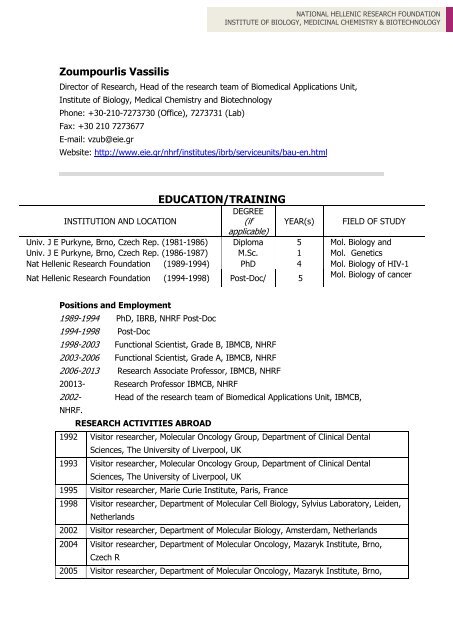

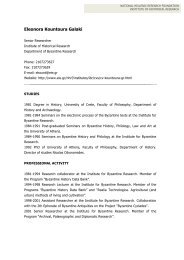

![PUBLICATIONS [Greek titles are translated into English] 1. Mapping ...](https://img.yumpu.com/51187923/1/184x260/publications-greek-titles-are-translated-into-english-1-mapping-.jpg?quality=85)
